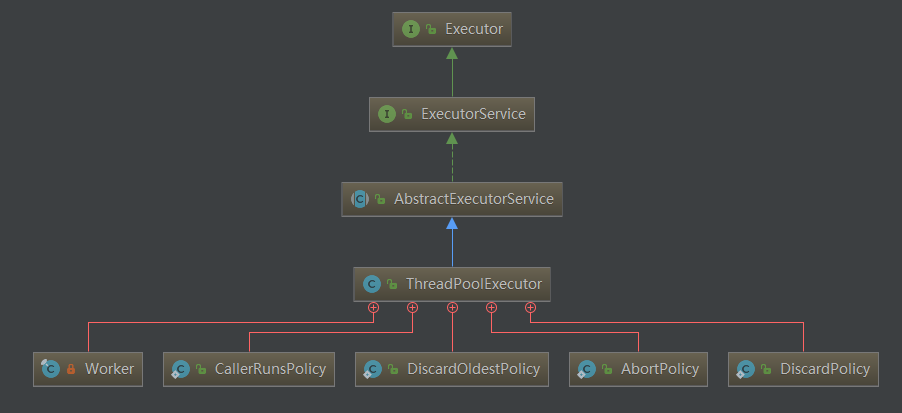记在前面
注:源代码基于 Java 1.8。
ThreadPoolExecutor继承了AbstractExecutorService,实现了ExecutorService接口,而ExecutorService接口继承了Executor接口。类图如下:
线程池
线程池利用的是池化思想,线程放在这个池子中进行重复利用,能够减去了线程的创建和销毁所带来的代价(时间和资源)。
线程池的作用
- 复用线程
- 管理线程
- 控制最大并发数(降低资源消耗、提高响应速度)
ThreadPoolExecutor
ThreadPoolExecutor是线程池的具体实现类,一般所有的线程池都是基于这个类实现的。1
2
3
4
5
6
7
8
9// 构造方法
public ThreadPoolExecutor(int corePoolSize,
int maximumPoolSize,
long keepAliveTime,
TimeUnit unit,
BlockingQueue<Runnable> workQueue) {
this(corePoolSize, maximumPoolSize, keepAliveTime, unit, workQueue,
Executors.defaultThreadFactory(), defaultHandler);
}
- corePoolSize:线程池核心线程数量
- maximumPoolSize:线程池允许最大线程数量
- keepAliverTime:当活跃线程数大于核心线程数时,空闲的多余线程最大存活时间
- unit:存活时间的单位,一个枚举
- workQueue:存放任务的阻塞队列
- threadFactory:创建线程的工厂
- handler:超出线程范围和队列容量的任务的处理策略
ThreadPoolExecutor中,有两个重要的成员变量:workQueue和workers1
2
3
4// 存放任务的队列
private final BlockingQueue<Runnable> workQueue;
// 工作线程
private final HashSet<Worker> workers = new HashSet<Worker>();
常见的Java线程池
生成线程池使用的是Executors类对应的工厂方法,以下是常见的Java线程池:
FixedThreadPool
FixedThreadPool是固定数量的线程池,只有核心线程。每提交一个任务就是一个线程,直到达到线程池的最大核心数量,然后后面进入等待队列,直到前面的任务完成才继续执行。线程池的大小一旦达到最大值就会保持不变,如果某个线程因为执行异常而结束,那么线程池会补充一个新线程。1
2
3
4
5
6// corePoolSize等于maximumPoolSize,实现固定线程数量
public static ExecutorService newFixedThreadPool(int nThreads) {
return new ThreadPoolExecutor(nThreads, nThreads,
0L, TimeUnit.MILLISECONDS,
new LinkedBlockingQueue<Runnable>());
}
SingleThreadExecutor
SingleThreadExecutor是数量为1的线程池。线程池中每次只有一个线程在运行,单线程串行执行任务。如果这个唯一的线程因为异常结束,那么会有一个新的线程来替代它。1
2
3
4
5
6
7// corePoolSize等于maximumPoolSize等于1,实现线程数量永远为1
public static ExecutorService newSingleThreadExecutor() {
return new FinalizableDelegatedExecutorService
(new ThreadPoolExecutor(1, 1,
0L, TimeUnit.MILLISECONDS,
new LinkedBlockingQueue<Runnable>()));
}
CachedThreadPool
CachedThreadPool是可缓存线程的线程池。如果线程池的大小超过了处理任务所需要的线程,那么就会回收部分空闲(60秒不执行任务)的线程。当任务数增加时,此线程池又可以智能的添加新线程来处理任务。此线程池不会对线程池大小做限制,线程池大小完全依赖于操作系统(或者说JVM)能够创建的最大线程大小。其中,SynchronousQueue是一个是缓冲区为1的阻塞队列。1
2
3
4
5public static ExecutorService newCachedThreadPool() {
return new ThreadPoolExecutor(0, Integer.MAX_VALUE,
60L, TimeUnit.SECONDS,
new SynchronousQueue<Runnable>());
}
ScheduledThreadPool
ScheduledThreadPool是核心线程数固定,大小无限制的线程池,支持定时和周期性的执行线程。创建一个周期性执行任务的线程池。1
2
3
4
5
6
7// 调用ScheduledThreadPoolExecutor,ScheduledThreadPoolExecutor调用ThreadPoolExecutor
public static ExecutorService newScheduledThreadPool(int corePoolSize) {
// 直接跳过ScheduledThreadPoolExecutor构造方法
return new ThreadPoolExecutor(corePoolSize, Integer.MAX_VALUE,
0L, NANOSECONDS,
new DelayedWorkQueue());
}
线程池工作流程
- 线程池刚创建时,里面没有一个线程;
- 当添加一个任务(调用execute())方法时,线程池会做如下判断:
- 如果正在运行的线程数量小于corePoolSize,那么马上创建线程运行这个任务;
- 如果正在运行的线程数量大于或等于corePoolSize,那么将这个任务放入队列;
- 如果这时候队列满了,而且正在运行的线程数量小于maximumPoolSize,那么还是要创建非核心线程立刻运行这个任务;
- 如果队列满了,而且正在运行的线程数量大于或等于maximumPoolSize,那么线程池会抛出异常RejectExecutionException;
- 当一个线程完成任务时,它会从队列中取下一个任务来执行;
- 当一个线程无事可做,超过一定的时间(keepAliveTime)时,线程池会判断,如果当前运行的线程数大于corePoolSize,那么这个线程就被停掉。所以线程池的所有任务完成后,它最终会收缩到 corePoolSize 的大小。
运用
提交
创建线程池通过Executors的工厂方法,执行任务有两种方式execute和submit来提交一个任务到线程池中,如下:
execute
1
ExecutorService.execute(Runnable command);
submit
1
2
3
4// 本质还是调用execute
Future<T> futureTask = ExecutorService.submit(Callable<T> task);
Future futureTask = ExecutorService.submit(Runnable task);
Future<T> futureTask = ExecutorService.submit(Runnable task, T Result);
execute()
所以核心的逻辑就是execute()方法了,如下:1
2
3
4
5
6
7
8
9
10
11
12
13
14
15
16
17
18
19
20
21
22
23
24
25
26
27
28
29public void execute(Runnable command) {
if (command == null)
throw new NullPointerException();
// 获取当前线程数
int c = ctl.get();
// 当前线程数量小于coreSize 时
if (workerCountOf(c) < corePoolSize) {
// 直接启动新的线程
if (addWorker(command, true))
return;
c = ctl.get();
}
// 当前线程数量大于等 coreSize 时
// runState为RUNNING && 队列未满
if (isRunning(c) && workQueue.offer(command)) {
int recheck = ctl.get();
// 再次检验是否为RUNNING状态
// 非RUNNING状态 则从workQueue中移除任务并拒绝
if (! isRunning(recheck) && remove(command))
reject(command);
// 防止了SHUTDOWN状态下没有活动线程了,但是队列里还有任务没执行这种特殊情况。
// 添加一个null任务是因为SHUTDOWN状态下,线程池不再接受新任务
else if (workerCountOf(recheck) == 0)
addWorker(null, false);
}
// 如果队列满了或者是非运行的任务都拒绝执行
else if (!addWorker(command, false))
reject(command);
}
Worker
Worker类,Worker 实现了Runnable接口,当Thread的start()方法得到调用时,执行的其实是Worker的run()方法,即runWorker()方法。runWorker()方法之中有一个 while 循环,使用getTask()来获取任务,并执行。getTask()是从 workQueue中获取的
runWorker()
1 | final void runWorker(Worker w) { |
getTask()
1 | // 是从 workQueue中获取的 |
拒绝策略
当线程池的任务缓存队列已满并且线程池中的线程数目达到maximumPoolSize,如果还有任务提交就会采取任务拒绝策略,有以下四种策略:
- AbortPolicy:抛RejectedExecutionException异常,默认的拒绝策略
- DiscardPolicy:直接丢弃,但是不抛出异常
- DiscardOldestPolicy:丢弃队列最前面的任务,然后重新尝试执行任务(重复此过程)
- CallerRunsPolicy:由调用线程处理该任务
1
2
3
4ThreadPoolExecutor.AbortPolicy:抛RejectedExecutionException异常
ThreadPoolExecutor.DiscardPolicy:直接丢弃,但是不抛出异常
ThreadPoolExecutor.DiscardOldestPolicy:丢弃队列最前面的任务,然后重新尝试执行任务
ThreadPoolExecutor.CallerRunsPolicy:由调用线程处理该任务